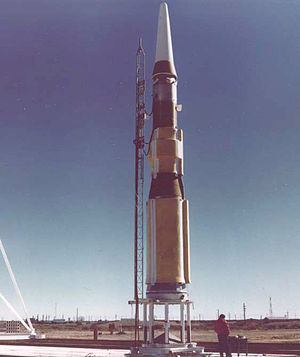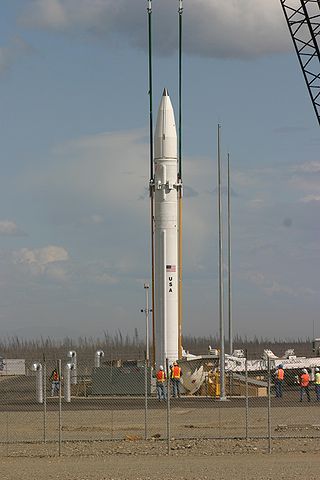
An anti-ballistic missile (ABM) is a surface-to-air missile designed to counter ballistic missiles. Ballistic missiles are used to deliver nuclear, chemical, biological, or conventional warheads in a ballistic flight trajectory. The term "anti-ballistic missile" is a generic term for a system designed to intercept and destroy any type of ballistic threat; however, it is commonly used for systems specifically designed to counter intercontinental ballistic missiles (ICBMs).

The Boeing YAL-1 airborne laser testbed was a modified Boeing 747-400F with a megawatt-class chemical oxygen iodine laser (COIL) mounted inside. It was primarily designed to test its feasibility as a missile defense system to destroy tactical ballistic missiles (TBMs) while in boost phase. The aircraft was designated YAL-1A in 2004 by the U.S. Department of Defense.
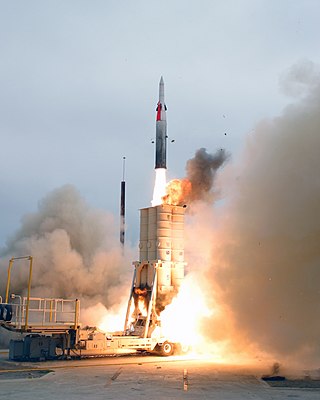
The Arrow or Hetz is a family of anti-ballistic missiles designed to fulfill an Israeli requirement for a missile defense system that would be more effective against ballistic missiles than the MIM-104 Patriot surface-to-air missile. Jointly funded and produced by Israel and the United States, development of the system began in 1986 and has continued since, drawing some contested criticism. Undertaken by the MALAM division of the Israel Aerospace Industries (IAI) and Boeing, it is overseen by the Israeli Ministry of Defense's "Homa" administration and the U.S. Missile Defense Agency. It forms the long-range layer of Israel's multi-tiered missile defence system, along with David's Sling and Iron Dome and Iron Beam [experimental].
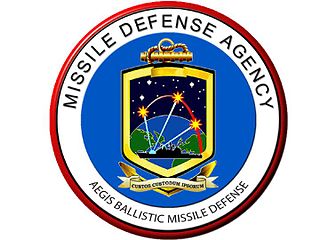
The Aegis ballistic missile defense system, also known as Sea-Based Midcourse, is a Missile Defense Agency program under the United States Department of Defense developed to provide missile defense against short and intermediate-range ballistic missiles. The program is part of the United States national missile defense strategy and European NATO missile defense system.

White Sands Missile Range (WSMR) is a United States Army military testing area and firing range located in the US state of New Mexico. The range was originally established in 1941 as the Alamogordo Bombing and Gunnery Range, where the Trinity test site lay at the northern end of the Range, in Socorro County near the towns of Carrizozo and San Antonio. It then became the White Sands Proving Ground on 9 July 1945.

National missile defense (NMD) refers to the nationwide antimissile program the United States has had under development since the 1990s. After the renaming in 2002, the term now refers to the entire program, not just the ground-based interceptors and associated facilities.

The Pacific Missile Range Facility, Barking Sands is a U.S. naval facility and airport located five nautical miles (9 km) northwest of the central business district of Kekaha, in Kauai County, Hawaii, United States.

Terminal High Altitude Area Defense (THAAD), formerly Theater High Altitude Area Defense, is an American anti-ballistic missile defense system designed to intercept and destroy short-, medium-, and intermediate-range ballistic missiles in their terminal phase. The THAAD interceptor carries no warhead, instead relying on its kinetic energy of impact to destroy the incoming missile. THAAD was developed after the experience of Iraq's Scud missile attacks during the Gulf War in 1991.

The Missile Defense Agency (MDA) is a component of the United States government's Department of Defense responsible for developing a comprehensive defense against ballistic missiles. It had its origins in the Strategic Defense Initiative (SDI) which was established in 1983 by Ronald Reagan and which was headed by Lt. General James Alan Abrahamson. Under the Strategic Defense Initiative's Innovative Sciences and Technology Office headed by physicist and engineer Dr. James Ionson, the investment was predominantly made in basic research at national laboratories, universities, and in industry. These programs have continued to be key sources of funding for top research scientists in the fields of high-energy physics, advanced materials, nuclear research, supercomputing/computation, and many other critical science and engineering disciplines—funding which indirectly supports other research work by top scientists, and which was most politically viable to fund from appropriations for national defense. It was renamed the Ballistic Missile Defense Organization in 1993, and then renamed the Missile Defense Agency in 2002. The current director is Lieutenant General Heath A. Collins.

Missile defense is a system, weapon, or technology involved in the detection, tracking, interception, and also the destruction of attacking missiles. Conceived as a defense against nuclear-armed intercontinental ballistic missiles (ICBMs), its application has broadened to include shorter-ranged non-nuclear tactical and theater missiles.

The AN/FPS-108 COBRA DANE is a PESA phased array radar installation operated by Raytheon for the United States Space Force at Eareckson Air Station on the island of Shemya, Aleutian Islands, Alaska. The system was built in 1976 and brought online in 1977 for the primary mission of gathering intelligence about Russia's ICBM program in support of verification of the SALT II arms limitation treaty. Its single face 29 m (95 ft) diameter phased array radar antenna 52.7373°N 174.0914°E faces the Kamchatka Peninsula and Russia's Kura Test Range. COBRA DANE operates in the 1215–1400 MHz band and can track items as small as a basketball sized drone at distances of several hundred miles.

The RIM-161 Standard Missile 3 (SM-3) is a ship-based surface-to-air missile used by the United States Navy to intercept short- and intermediate-range ballistic missiles as a part of Aegis Ballistic Missile Defense System. Although primarily designed as an anti-ballistic missile, the SM-3 has also been employed in an anti-satellite capacity against a satellite at the lower end of low Earth orbit. The SM-3 is primarily used and tested by the United States Navy and also operated by the Japan Maritime Self-Defense Force.
A number of suborbital spaceflights were conducted during 2008. These consist mostly of sounding rocket missions and missile tests, and include other flights such as an ASAT firing. Between the start of the year and 16 July, at least 43 publicly announced suborbital spaceflights were conducted, the first of them on 11 January.
The Space Tracking and Surveillance System was a pair of satellites developed by the United States Missile Defense Agency (MDA) to research the space-based detection and tracking of ballistic missiles. Data from STSS satellites could allow interceptors to engage incoming missiles earlier in flight than would be possible with other missile detection systems. The STSS program began in 2001, when the "SBIRS Low" program was transferred to MDA from the United States Air Force. In December 2002, SBIRS Low Research & Development was renamed Space Tracking and Surveillance System (STSS).

The EL/M-2080 Green Pine is an Israeli ground-based missile defense radar produced by Elta Systems, a subsidiary of Israel Aerospace Industries, to operate mainly with the Arrow theater missile defense system of Israel, which is jointly funded and produced with the United States. The system was exported to India, and its advanced version, the Green Pine Block-B, was delivered to South Korea at a cost of $83 million per unit, and to Azerbaijan. The Israeli Air Defense Command within the Israeli Air Force (IAF) of the Israel Defense Forces (IDF) operates both Green Pine radars and Green Pine Block-B radars as an integral part of the Arrow system.

Missile defense systems are a type of missile defense intended to shield a country against incoming missiles, such as intercontinental ballistic missiles (ICBMs) or other ballistic missiles. The United States, Russia, India, France, Israel, Italy, United Kingdom, China and Iran have all developed missile defense systems.
Space Vector Corporation (SVC) is a United States-based company that provides aerospace products and services to government and commercial customers. Space Vector is headquartered in Chatsworth, California and is a privately held small business. Its primary products are flight safety and system batteries, GPS tracking systems, custom avionics and structures, attitude control systems, pneumatic components, and separation systems. Space Vector also provides launch services as a prime contractor under the Space and Missile Systems Center (SMC) Sounding Rocket Program (SRP-3) which includes performing vehicle integration activities, end-to-end system testing, payload integration, launch operations, and mission analysis and design.

The Pershing II Weapon System was a solid-fueled two-stage medium-range ballistic missile designed and built by Martin Marietta to replace the Pershing 1a Field Artillery Missile System as the United States Army's primary nuclear-capable theater-level weapon. The U.S. Army replaced the Pershing 1a with the Pershing II Weapon System in 1983, while the German Air Force retained Pershing 1a until all Pershings were eliminated in 1991. The U.S. Army Missile Command (MICOM) managed the development and improvements, while the Field Artillery Branch deployed the systems and developed tactical doctrine.
In air and missile defense (AMD), the Integrated Air-and-Missile Defense system (IAMD) is an United States Army Space and Missile Defense Command (USASMDC) research program to augment the aging surface-to-air missile defense systems and to provide the United States Army with a low-cost, but effective complement to kinetic energy solutions to take out air threats. Brigade level higher energy lasers are used in truck mounted systems called HELMTT. At lower levels, the Army needs to develop interceptors that don't cost more than small, unmanned aircraft systems. In early research they have successfully used 5-kilowatt lasers on a Stryker combat vehicle. The Mobile Expeditionary High-Energy Laser (MEHEL) was used at MFIX at Fort Sill, Oklahoma, in the first half of April, 2017.
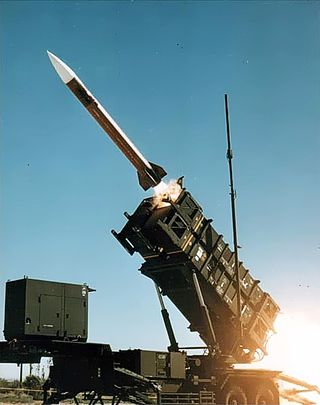
The United States Army Integrated Air and Missile Defense [IAMD] Battle Command System (IBCS) is a plug-and-fight network intended to let a radar or any other defensive sensor feed its data to any available weapon—colloquially, "connect any sensor to any shooter". The IBCS is designed to link radars across thousands of miles and shoot down short-, medium-, and intermediate-range ballistic missiles in their terminal phase.
